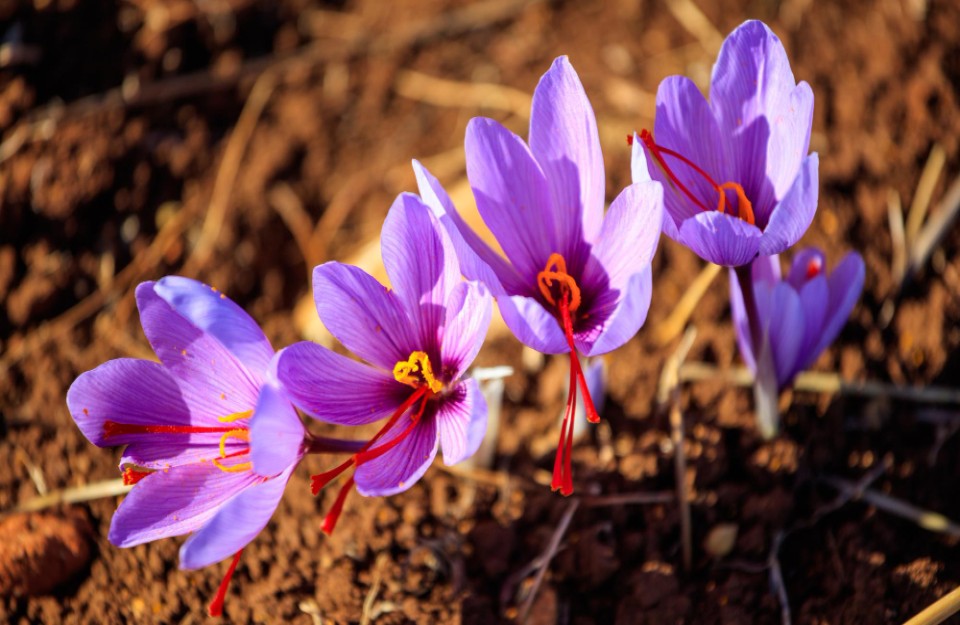
Saffron cultivation holds immense significance not just within India but also on a global scale as a valuable and premium spice crop. Saffron cultivation primarily involves the Corm Method. Initially, the corm sprouts, eventually leading to the emergence of approximately 1-5 violet flowers adorned with reddish-orange stigma. Saffron finds utility not only for its flavor in culinary applications but also for its vibrant color.
In India, saffron is predominantly cultivated in the Pulwama, Srinagar, and Kishtwar districts of Jammu and Kashmir. Additionally, saffron cultivation occurs in regions across Jammu, Uttar Pradesh, Himachal Pradesh, Bihar, and Madhya Pradesh. The demand for saffron in India amounts to 100 metric tons annually. However, its yearly production falls short of 6.46 tons, spread across 2,825 hectares of land. On a global scale, saffron production reaches 418 metric tons per annum. Iran leads as the largest producer of saffron, contributing to 90% of the world's saffron output, followed by Greece and India.
Saffron encapsulates a wealth of flavors and characteristics within its vivid hue. The highest saffron production in India takes place in Pampore, Kashmir. A cold climate and conducive environment are imperative for successful saffron cultivation, rendering the chilly valleys of Jammu and Kashmir ideal for this purpose. Derived from the crocus plant, saffron serves as a spice, finding applications not only in culinary ventures but also in medicinal and cosmetic domains.
To initiate saffron cultivation, the soil should be meticulously tilled to a depth of 25-35 centimeters, with the field plowed 3-4 times. Ensuring adequate spacing, saffron bulbs should be planted between rows spaced 15-20 centimeters apart and at a depth of 1.2-1.5 meters. Installation of irrigation channels between the rows is recommended. In regions characterized by sandy loam soil and minimal rainfall, where irrigation is unnecessary, the construction of irrigation channels may be omitted. For optimal yields, a spacing of 20x10 centimeters between saffron bulbs is advised.
Advanced Saffron Varieties
There are two primary advanced varieties of saffron:
Temperature plays a crucial role in regulating the growth of saffron plants and flowers, with cold temperatures during flowering being beneficial. Saffron is cultivated at elevations ranging from 1500 to 2800 meters above sea level in dry, temperate climates. An optimal temperature of 23-27 degrees Celsius is suitable for the growth of saffron corms and flowers.
For optimal saffron production, soil with a pH value between 6.8 and 7.8 and sandy loam texture is preferred. Excessive water can lead to saffron corms rotting and deteriorating. Mixing sand with indigenous manure enhances soil fertility and improves production. Additionally, the addition of calcium carbonate promotes crop growth for higher yields.
Saffron Irrigation: Saffron cultivation necessitates minimal water usage. Irrigation should be conducted for saffron between late September and October, with intervals of approximately 15 days.
Saffron Planting Time: The optimal period for planting saffron is from September to October. In mountainous regions, saffron is typically planted on September 15th, while in mid-mountainous areas, planting occurs before October.
Read More... How to do Black Pepper Cultivation india
Hydroponic Method for Saffron Cultivation: The hydroponic method resembles hydroponics, wherein plants are grown using water and steam facilitated by machinery. This technique eliminates the need for both water and soil. It is commonly employed in foreign countries for saffron cultivation. With this method, saffron crops can be harvested once annually. The plants are nurtured through a blend of air and water. Successful cultivation can be achieved even in limited space using this method. Following the blossoming of saffron flowers, organic fertilizers and nutrients become necessary. Furthermore, this technique is applicable for the cultivation of fruits and vegetables.
Benefits and Uses of Saffron
Harvesting